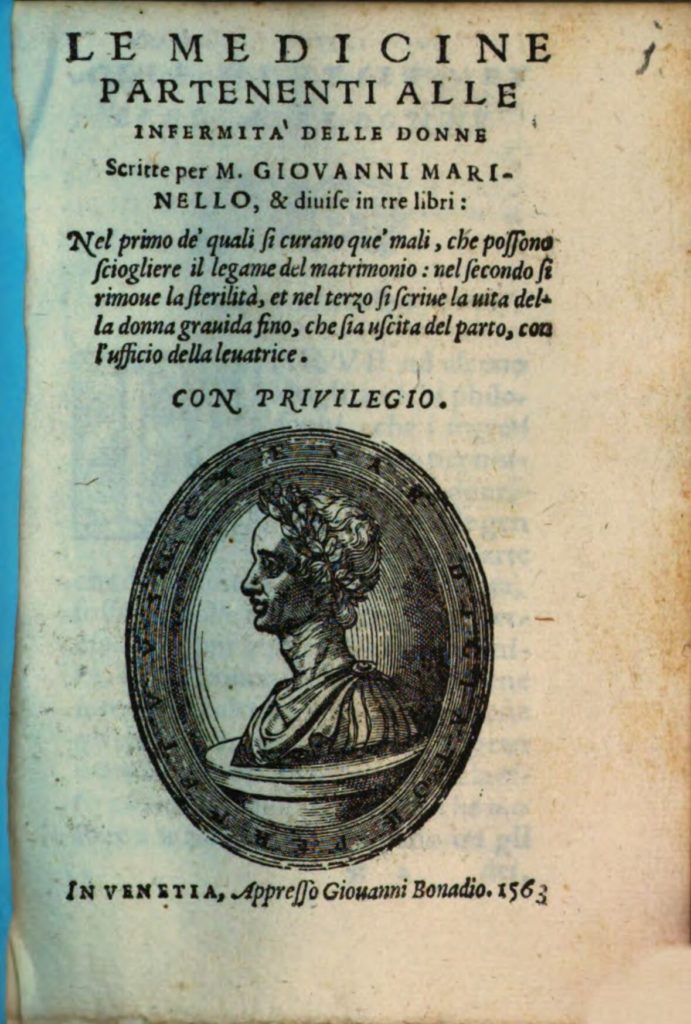Trois livres
| Title | Trois livres appartenans aux infirmitez et maladies des femmes |
|---|---|
| Contributor(s) |
Marinello, Giovanni (author) Liébault, Jean (translator) |
| Year | 1563, 1582 |

This is a visualisation taken from Voyant Tools which shows the most common words and concerns of this text and how it pertains to the female body. The physical female body is to the fore, with words like ‘corps’, ‘ventre’ and ‘matrice’ being employed often. The dual concerns of menstruation (‘sang’) and childbirth (‘l’enfant’) can be found in this text.
At the close of the 16th century Trois livres appartenans aux infirmitez et maladies des femmes, also published as Des maladies des femmes et remedes d’ycelles en trois livres emerges, onto the French publication scene. This mammoth source in particular is a great example of the republishing environment that occurred in Early Modern Europe. Trois livres is a French language translation of the Italian work Le Medicine partenenti alle infermità delle donne by Giovanni Marinello published in Venice circa 1563. Translating Marinello’s work in 1582, Jean Liébault (1534?-1596) published the work in two volumes under the title Trois livres appartenans aux infirmitez et maladies des femmes ; pris du latin de M. Jean Liebaut,… et faicts françois. This Latin edition he claimed to have used did not actually exist, rather he fabricated this claim to legitimise his translation work.




Voyant Tools describes Trends as “a visualization that represents the frequencies of terms across documents in a corpus or across segments in a document”. This graph gives various insights into how the body is present across each segment of the text. The womb (‘matrice’) is always present, and has the highest number of relative mentions. Mentions to blood (‘sang’) fluctuate, while the discussion is always centred on the woman (‘femme’).
Marinello and Liébault both would have encountered similar circumstances as authors on female health, being separated by only two decades. They were writing at a pivotal time in historical gynaecology, as Hippocrates’ works had only recently been translated into Latin in 1525 by Marcus Fabius Calvus. This ‘new’ ancient voice and authority on the female body was thus ready to be examined and incorporated in medical thought by scholars of the 16th century. Unlike Joubert, their contemporary both temporally and geographically, Liébault and Marinello subscribe to Hippocrates’ school of thought on some aspects of the female body.
During the Renaissance, schools of medical theory were attributed to the largest of the three voices and many modern-day scholars separate Renaissance theorists into Hippocratics, Aristotleians, and Galenics (MacLean, 1983). As more Classical works were being printed within the 16th century, more information came to light which either amplified or challenged the beliefs displayed in our sources.
Consult the 1598 edition.
We make use of one source for this text, the 1582 first edition which is hosted by Google Books, from which also serves as the source of the .txt file. This edition lists Liébault as the original author, but we have elected to cite Marinello and Liébault as authors both. A 1598 edition hosted by the Bibliothèque Nationale de France was in consideration for our corpus as well but we ultimately elected to choose the earlier edition, due to the availability of the .txt file. However, we have embedded that version here as they facilitate easy open source access. The original 1563 Italian edition is hosted by the Bayerische Staatsbibliothek.



